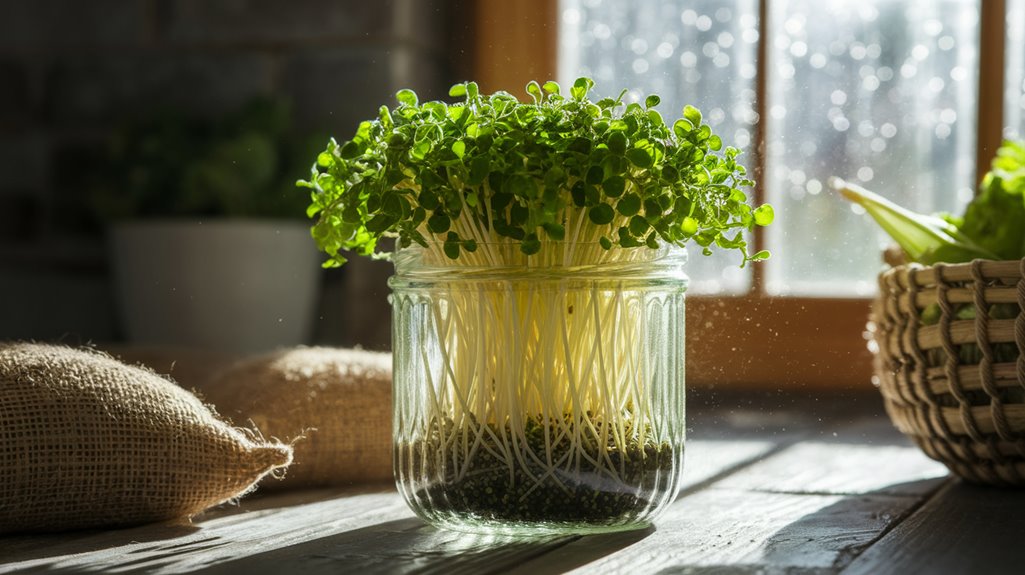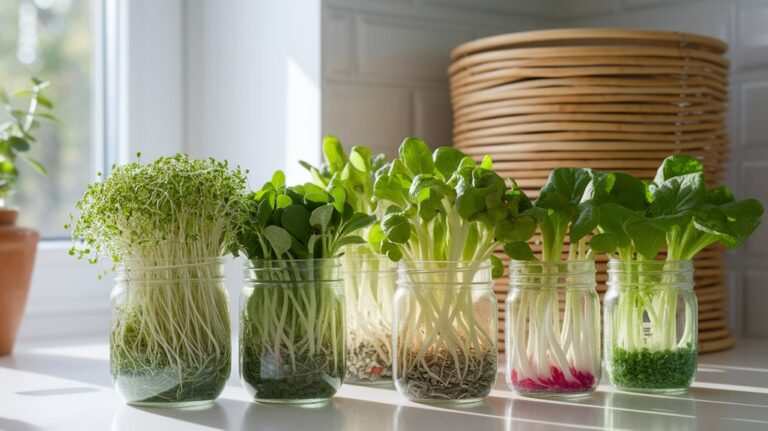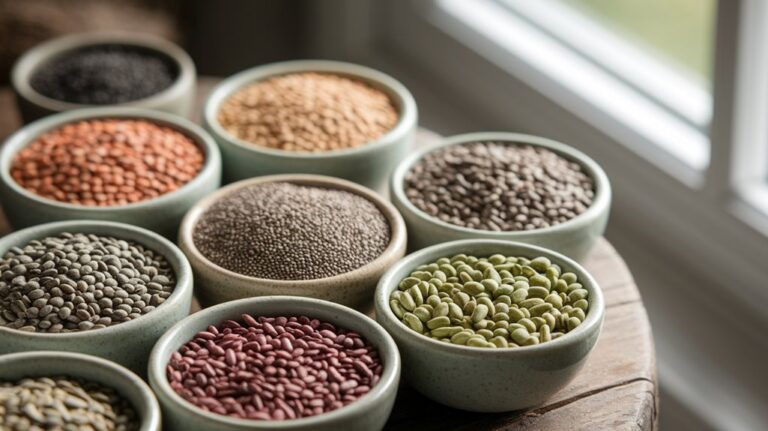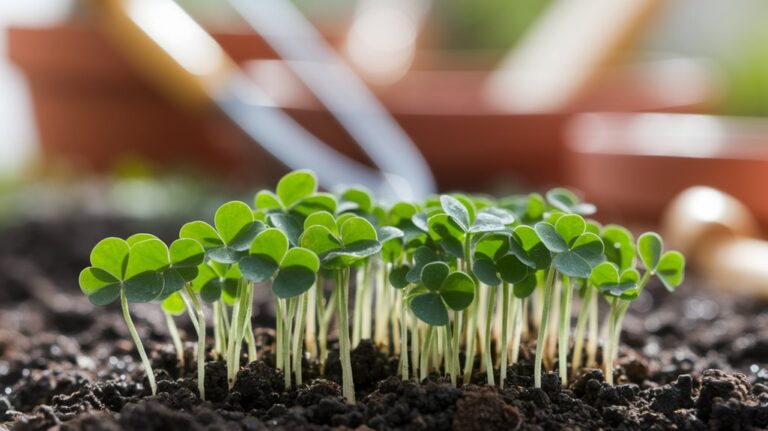How to Grow Alfa-Alfa Sporouting Seeds
To grow alfalfa sprouts, I start by measuring about two tablespoons of high-quality alfalfa seeds and rinsing them thoroughly. Then, I soak the seeds in water overnight before draining. I secure a breathable lid on a sprouting jar, placing it in a warm, dark spot. I rinse the seeds twice daily, keeping them moist but not waterlogged. Once they’re about 1-2 inches tall and exposed to indirect sunlight, they’re ready to harvest. There’s even more to discover on how to use these nutritious sprouts in your meals.
Key Takeaways
- Start by measuring two tablespoons of high-quality alfalfa seeds and rinse them thoroughly to prevent contamination.
- Soak the rinsed seeds in water overnight, then drain the excess water.
- Place the seeds in a sprouting jar with a breathable lid in a warm, dark area.
- Rinse the seeds twice daily to keep them moist, avoiding waterlogging.
- Expose the jar to indirect sunlight before harvesting when sprouts reach 1-2 inches tall.
What Are Alfalfa Sprouts?
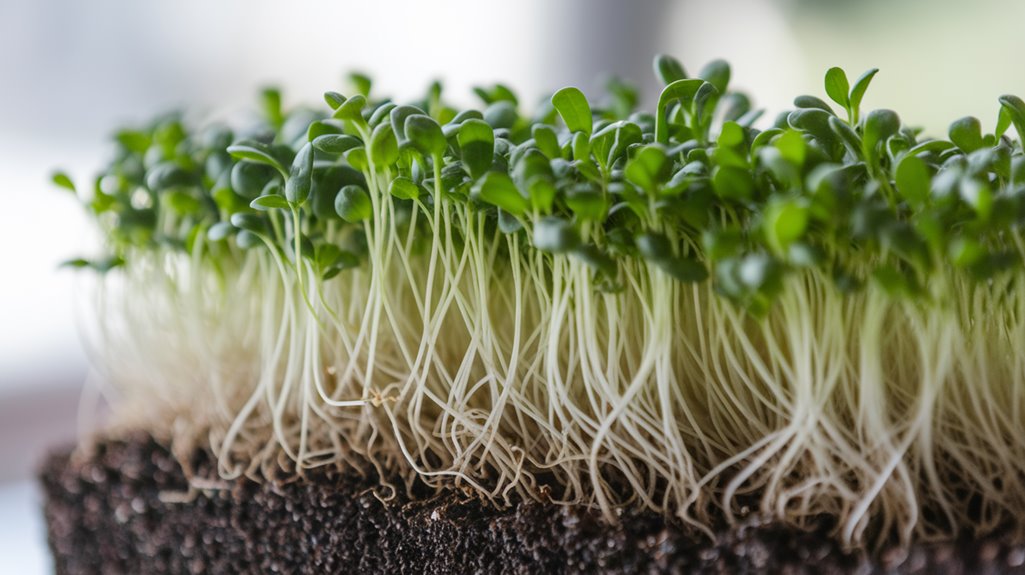
Alfalfa sprouts are tender, green shoots that emerge from alfalfa seeds, scientifically known as Medicago sativa. These sprouts typically grow to about one to two inches in height and have a delicate, crisp texture.
When I cultivate them, I appreciate their pale green color and slightly nutty flavor, which adds a unique touch to various dishes. Alfalfa sprouts are particularly notable for their rich nutrient profile, containing vitamins A, C, E, and K, as well as essential minerals.
They’re often used in salads, sandwiches, and wraps, providing not only a nutritional boost but also a fresh crunch. Their rapid growth cycle makes them an ideal choice for home sprouting, allowing me to enjoy fresh greens year-round.
Benefits of Growing Alfalfa Sprouts
Growing alfalfa sprouts offers numerous benefits that extend beyond their delightful taste.
First, they’re packed with essential nutrients, including vitamins A, C, E, and K, as well as minerals like calcium and magnesium. This nutrient density makes them a fantastic addition to my diet.
Second, alfalfa sprouts are low in calories and high in fiber, promoting digestive health and aiding in weight management. I’ve also found that their antioxidant properties support overall wellness by combating oxidative stress.
Moreover, growing my own sprouts is an economical choice that allows me to access fresh produce year-round.
Finally, cultivating alfalfa sprouts is simple and quick, making it an enjoyable and rewarding experience for anyone looking to enhance their meals with nutritious greens.
Materials Needed for Sprouting
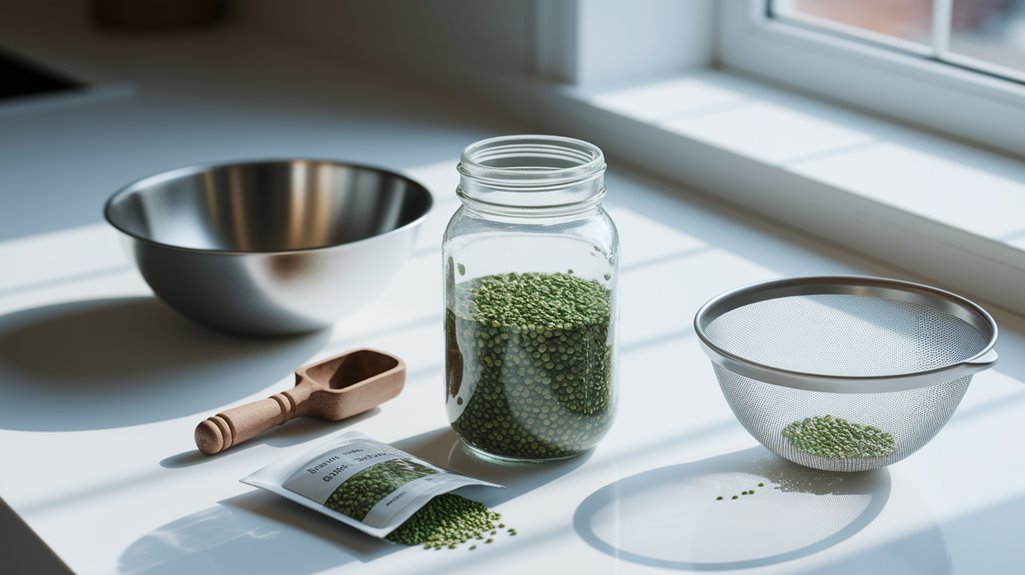
To successfully sprout alfalfa seeds, I’ll need some essential equipment and high-quality seeds.
The right tools ensure a smooth process, while the quality of the seeds directly affects the health of the sprouts.
Let’s explore what you’ll need to get started.
Essential Sprouting Equipment
While you might think sprouting alfalfa seeds is a simple task, having the right equipment is crucial for success.
First, I recommend a sprouting jar, which has a mesh lid for proper airflow and drainage. Alternatively, you can use a sprouting tray, but ensure it has ample drainage holes.
You’ll also need clean water for rinsing, as this keeps your seeds hydrated and free from contaminants. A light cloth or paper towel can be helpful for covering the jar, creating a dark environment for sprouting.
Lastly, a measuring spoon is useful for portioning seeds accurately. With these essential items, you’ll set yourself up for a successful and rewarding sprouting experience.
Seed Quality Importance
Selecting high-quality alfalfa seeds is fundamental to successful sprouting. The quality of the seeds directly impacts germination rates and the nutritional value of the sprouts.
I’ve found that when I invest in good seeds, the results are consistently better. Here are some key factors to consider:
- Germination Rate: Look for seeds with a high germination percentage, ideally above 90%.
- Organic Certification: Choose organic seeds to ensure no harmful chemicals are present.
- Freshness: Check the packaging date; fresher seeds sprout more reliably.
- Non-GMO: Ensure seeds are non-genetically modified for better health benefits.
- Storage Conditions: Properly stored seeds maintain their viability longer.
Step-by-Step Guide to Sprouting Alfalfa Seeds
When I began sprouting alfalfa seeds, I quickly realized that a systematic approach was essential for success. First, I measured out about two tablespoons of high-quality alfalfa seeds and rinsed them thoroughly under cool water.
Next, I placed the seeds in a jar, covering them with water and letting them soak overnight. After draining the water, I secured a breathable lid over the jar and placed it in a warm, dark area.
I rinsed the seeds twice daily, ensuring they stayed moist but not waterlogged. Within a few days, I noticed tiny sprouts emerging.
Finally, I exposed the jar to indirect sunlight to green the sprouts before harvesting. This straightforward process yielded fresh, nutritious alfalfa sprouts ready to enjoy!
Caring for Your Alfalfa Sprouts
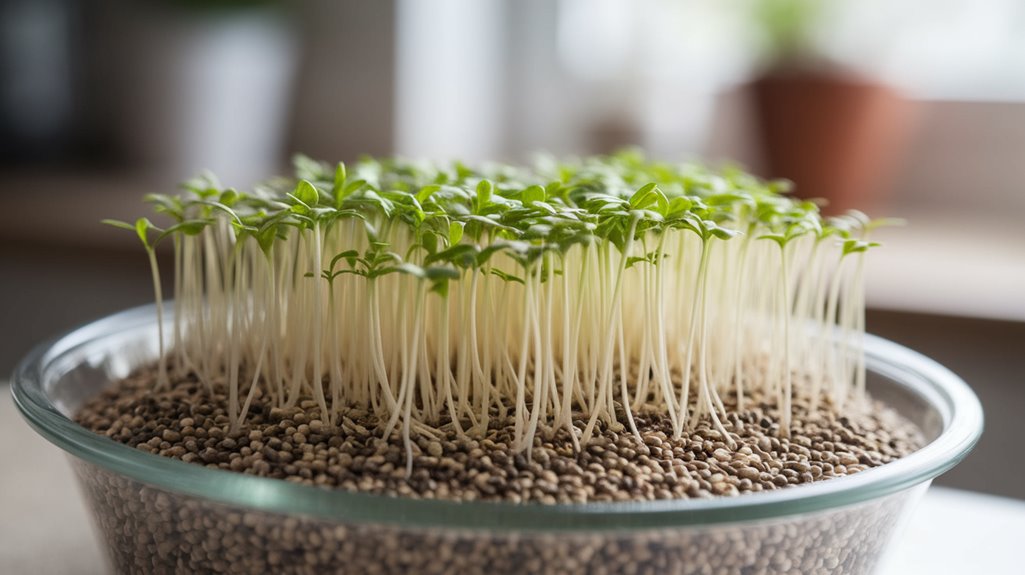
Caring for my alfalfa sprouts requires a consistent watering routine to ensure they thrive.
I also need to pay attention to their light requirements, as proper exposure is crucial for healthy growth.
Finally, I’ll share some effective harvesting techniques that maximize yield and freshness.
Watering Routine Importance
Although it might seem simple, establishing a consistent watering routine is crucial for the health and growth of your alfalfa sprouts. I’ve found that proper hydration directly impacts sprout development, so I make it a priority.
Here’s what I keep in mind:
- Watering should be done twice a day to maintain moisture.
- Use a fine mist spray to avoid displacing the seeds.
- Ensure excess water drains away to prevent rot.
- Monitor humidity levels; too much can lead to mold.
- Adjust the routine based on temperature and sprout growth stages.
Light Requirements Explained
Light plays a pivotal role in the growth of alfalfa sprouts, and understanding their specific requirements can enhance your success.
Alfalfa sprouts thrive in bright, indirect light. I’ve found that placing them near a window with filtered sunlight works best. Direct sunlight can be too harsh and might lead to overheating or drying out the sprouts.
Ideally, they need about 12 hours of light each day to develop properly. If natural light is insufficient, using fluorescent or LED grow lights can provide the necessary spectrum without generating excess heat.
I recommend maintaining a distance of about 12 inches from the light source. Monitoring their growth closely ensures you adjust the light conditions as needed, fostering healthy, robust sprouts.
Harvesting Techniques Tips
Harvesting alfalfa sprouts at the right time is crucial for maximizing their flavor and nutritional value. I usually wait until the sprouts are about 1 to 2 inches tall and have developed their first true leaves.
Here are some tips I’ve found helpful:
- Use clean scissors: This prevents contamination and keeps sprouts fresh.
- Harvest in the morning: Mornings are ideal since sprouts are crisp and full of moisture.
- Rinse thoroughly: After cutting, rinse the sprouts to remove any debris or seed hulls.
- Dry properly: Use a salad spinner or towel to remove excess moisture before storage.
- Store in the fridge: Keep your sprouts in a sealed container to maintain freshness for up to a week.
Following these techniques enhances the enjoyment of your homegrown alfalfa sprouts.
Harvesting Alfalfa Sprouts
When the alfalfa sprouts reach about 2 to 3 inches in height, it’s the perfect time to collect them. I find it essential to use clean scissors for a precise cut, ensuring I avoid damaging the roots. Harvesting in the morning is ideal, as the sprouts are crisp and full of moisture. After cutting, rinse them gently under cool water to remove any residue.
Here’s a quick comparison of harvest timing and quality:
| Timing | Sprout Quality |
|---|---|
| 2 inches | Crunchy and tender |
| 3 inches | Firm with slight crunch |
| Over 3 inches | Woody and bitter |
Delicious Ways to Use Alfalfa Sprouts in Your Meals
Although I often enjoy alfalfa sprouts straight from the garden, their versatility makes them an excellent addition to a variety of dishes. Incorporating these crunchy, nutrient-rich sprouts into my meals not only enhances flavor but also boosts the overall nutritional profile.
Here are some delicious ways I use alfalfa sprouts:
- Salads: They add a refreshing crunch and earthy taste.
- Sandwiches: I love layering them in wraps or between slices of bread for added texture.
- Smoothies: Tossing a handful into my morning smoothie enhances its nutrient content without overpowering the flavor.
- Stir-fries: I sprinkle them in at the end for a fresh finish.
- Tacos: They’re a great topping for a burst of flavor and crunch.
These methods showcase alfalfa sprouts’ adaptability in my kitchen.
Frequently Asked Questions
Conclusion
In conclusion, growing alfalfa sprouts is a straightforward process that yields nutritious results. With just a few materials and some dedication, you can enjoy the fresh taste and health benefits of these sprouts at home. By following the steps outlined and caring for your sprouts properly, you’ll not only enhance your meals but also add a valuable source of vitamins and minerals to your diet. So, why not give it a try and elevate your culinary creations?

